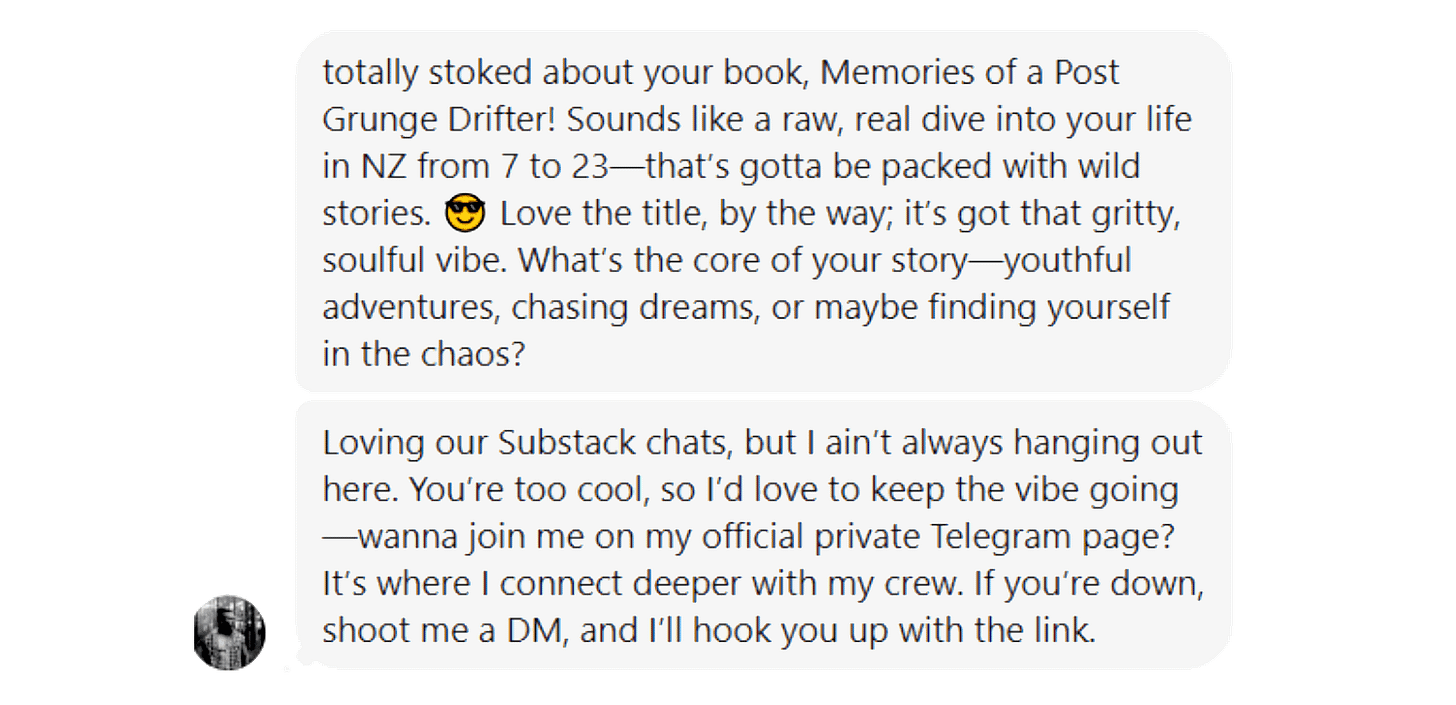Tiddies and a Six Pack, Here Come the Flattery Scammers
PRACTICALITY: Sharpening your spidey-senses for the Substack sharks
HAVE YOU BEEN GETTING SUBSCRIBERS, followers or commenters on Substack who fit this profile? A winsome, low-key-sexy headshot. Cheerful greeting… “Hi!”. A profile with no Posts and barely any Notes. Their messages surfacing some vague knowledge of your content… which… they… adore!
These are the flattery scammers. They’re out to get you, and here’s how it works.
The Setup
Finding you is easy. You’re posting on Substack, you relish conversations here, and Substack has a built-in mechanism for being contacted. So far, so social media.
The first you know of the scammer is probably their (free) subscription to your stack. It looks genuine, because they don’t really say much. They may not even bother subscribing, but contact you merely as a follower or in a comment to your Note.
The scammer is extremely unlikely to be a real, sitting-in-their-basement, sweating-over-the-grift person. It’s almost always an auto-generated nothing, no ability to be offended by your response, emotionless, a robot, cloned in software en masse. Increasingly (and effectively) it uses AI to sound more human.
As in all con-tricks, the first step in the flattery scam is to warm you up. In marketing terms, you’re a cold-call and they want to turn you into a hot lead. Obsequious charm is their tool, with wording that notably avoids details and, like a cold-reading at a seance, could apply to almost anybody. “Wow, amazing content!”… “You’re soooo talented!”… “This made me cry!” This little electric high-five gives you a glow – they noticed me! – and is especially effective on Substack because it’s a trap door for our monstrous, politely hidden egomania. Oh boy… an acolyte!
Here’s a prime example of the art, sent to
(I recommend following his Memories of a Post Grunge Drifter stack, it’s wildly entertaining.) Clearly a rehash of info that Obsidian Blackbird has already posted about his upcoming book, it reads like the mirror of a cover-blurb.So… they’re your new friend and you check out their profile. They have a plain name. The photo looks legit (AI generated or stolen from Instagram) and if they’re working hard, the vibe will appeal to your age/gender. Frequently, it’s a blonde culture-bud selfie in a summer dress, or semi-shirted windswept Chad fresh from the gym/surf. Likeable. Outdoorsy. A signature look is: no Posts in their profile, and any Notes tend to be bland AI content or restacks of genuine Posts from other accounts.
The Hook
This kicks off when you respond.
From the scammer’s point of view, Substack’s leisurely pace is a benefit. It’s no surprise to you that their answer (which used to come from a scripted tree of comments but is now more convincingly AI-generated) may be a few hours after you hit send on your response to them. So there’s no clue about the time zone that their system is using.
The actual content of any “conversation” is highly variable, but at some point they will try to hook you, with a nudge you to contact them on a secure messaging app (likely WhatsApp, Telegram, or Signal). These all have end-to-end encryption, so from that point on, your conversation is entirely private, no snoopers, no checkers, no moderators, no fellow Substackers waving their Stop!… Stop! hands.
The Funnel and The Sting
So you’re in their sales funnel now. A warmed-up lead, in a “personal conversation” with the new pal sales rep. You’re there because it kind-of feels authentic, like you’re maybe on the inside of something cool.
Things are about to take a turn. From here on, you could be talking to an AI-bot, or perhaps an actual person yawning on their laptop as they switch between multiple chats.
The U.S. Federal Trade Commission (FTC) tracks the types of fraud that are typically active social media recruitment scams, using its own data and information from the FBI. These include:
Investment Scams. Of the money reported lost to fraud via social media, more than half is lost to investment scams. This stuff includes fake cryptocurrency trading opportunities, bogus currency trading platforms, Ponzi schemes, and stock/share pump’n’dumps. The pattern is that your new, trusted contact will give fake examples of outlandish success, and lead you to the fraudulent websites or apps that are primed to take your money and disappear, or sell you real stocks that will plummet in value.
Romance Scams. This is the second-highest category. Half of online romance scam victims say it started on Facebook, Instagram or Snapchat. Now they’re coming for Substack, too. It’s a well-worn path: fake photos, love-bombing for emotional connection, perhaps some steaminess and a confessional mood, all building to increasing requests for cash for “emergencies” or travel tickets to visit you. Cash-requests stipulate the fraud-friendly routes of cryptocurrency, gift-cards or wire transfers. You pay up; they disappear.
Online Shopping Fraud. Here comes the dodgy link to an unmissable deal! It will never be delivered, recourse will be nil. The most common items are clothing and electronics.
Employment/Task-Based Scams. Not as common, but growing – particularly for tasks you can do at home that help to train AI systems. There’s promise of payment, but you can guess what happens.
“I’m too smart to get taken in”
You probably are. But intelligent, creative and educated could still mean gullible. Beware of appeals to your vanity or ego because, frankly my dears, that’s why you’re on Substack. Did you know you’re an easy mark?
The flip-side is that your intelligence is a shield. In researching this Post my most interesting discovery was learning about “self-selection filtering”.
It works like this. The scammer’s goal is to make money, not to waste your time. So they want their sales-funnel to be cost-effective, to find people who will fork over the cash. They’re certainly seeking gullibility, but the most productive aspect is simply inattentive desperation, a tendency to overlook details that get in the way of dreams.
So in the initial communication from the scammer, errors are a feature, not a bug!
A well-crafted scamming message will be a little “off”: clumsy, slightly ugly, unprofessional, with spelling errors. They do not want to find the sceptics, the close-readers, the eye-rollers who will never be persuaded to part with their money and can spot an obvious fraud. Their prey is uninformed, maybe a little cornered and seeking better things – easily drawn in by the promise of feeling “special”. Probably entrepreneurial, too (or at least they like to think so).
I used to see spam-emails and marvel that such a clunky design would get any takers at all. Their content so obviously sat in the uncanny valley between genuine business communication and outright nonsense. But I’m newly aware that the clumsiness of spam is its secret weapon. It filters for the easily fooled.
To Purge, or Not to Purge?
If you don’t engage with the flattery scammers then on the whole nothing will happen at all. You’ll just have an empty Substack follower or a meaningless plus-one on your subscriber-count.
But there’s potential for further entanglement if they remain on your subscriber list. The email address they have used to create the fake Substack account will be able to receive your Post notifications, and so they could continue to chew on your content, with potential for being able to AI-generate much more convincing, relevant conversations with you from fresh robots. “Hi! I was so touched by what you said about your bipolar episodes. It was so vivid! These things are really hard to talk about if you haven’t gone through the same trauma. 😢”
I think this is where the real danger lies. We can all hope to spot a Big Dumb Scam on the horizon. But as the robots begin to respond to specifics in your work, to be more fulsome with relevant praise and reactions, to feel like deeper connections, there’s a danger that you’ll start to believe in them.
So, even though there’s the pain of cutting your subscriber count, it’s worth hosing this crap out of the pipe.
You made it to the end! Enjoyed this post?
I love encouragement. A simple LIKE is so helpful. Sharing, Restacking or writing a Comment or Note is even better. My follower-count is “boutique” – I’ll notice you.
Feeling generous? Drop a tip in the jar or even buy a paid sub and feel the glow of tribute – you’re a Patron Of The Arts!







Hi, I loved this post. Very incisive, I felt a real connection to you. Is Tiddles your cat? Do you have telegram?
Thank you so much. I'll put this in my prayers to Jesus for wisdom and discernment